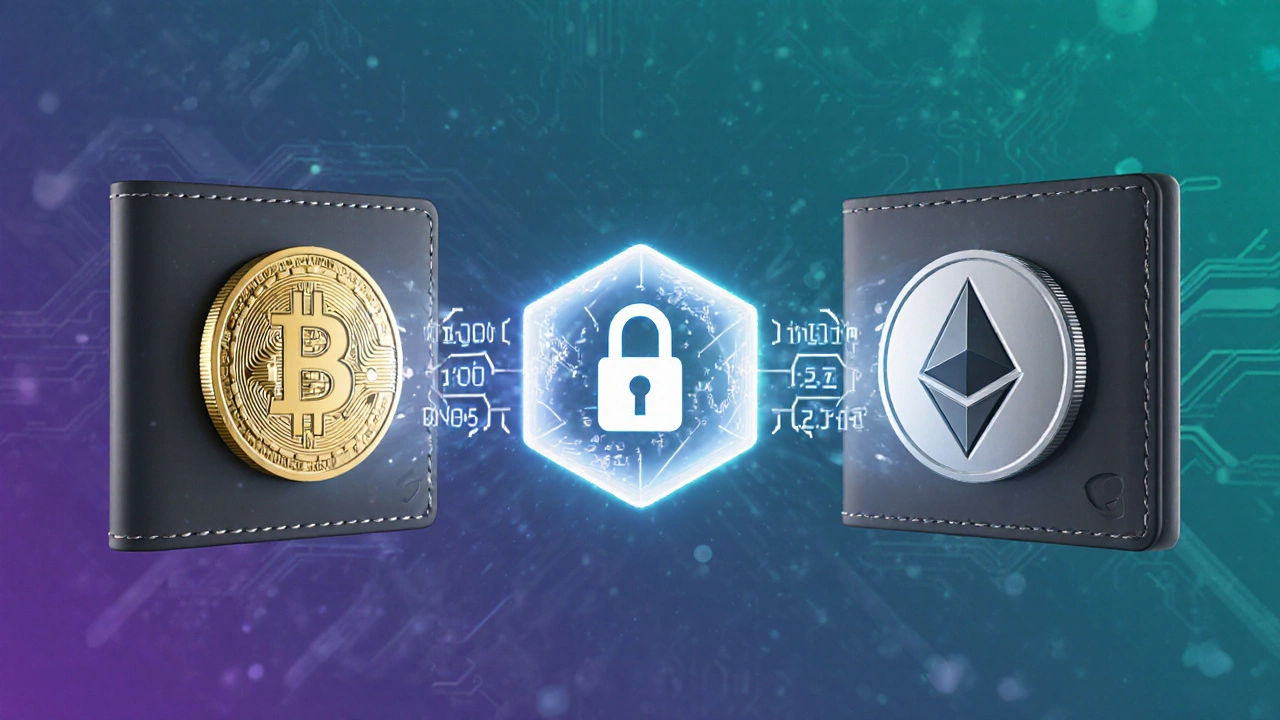When different blockchains need to talk, Blockchain interoperability refers to the set of protocols, standards, and tools that let separate ledger networks share data, assets, and functionality. This ability is what makes DeFi apps jump from Ethereum to Binance Smart Chain, lets NFTs move across metaverse platforms, and enables enterprise supply‑chain solutions to harness multiple private ledgers at once.
Understanding blockchain interoperability is crucial if you want to build or invest in multi‑chain projects that won’t be locked into a single silo.
Why Interoperability Matters
Each blockchain has its own strengths - some excel at speed, others at security, still others at low transaction costs. Without a way to connect them, users end up paying high fees to move assets manually, developers must duplicate code for each network, and the ecosystem stays fragmented.
- Liquidity: Assets can flow to the chain offering the best price.
- Scalability: Workloads can be split across fast sidechains while keeping a secure anchor.
- Innovation: New features can be prototyped on a testnet or specialized chain without disrupting the main network.
Core Mechanisms Behind Interoperability
There isn’t a one‑size‑fits‑all solution. Most projects combine several techniques:
1. Atomic Swaps
Atomic swaps are peer‑to‑peer exchanges that let users trade tokens across chains without a trusted intermediary. They rely on hash‑time‑locked contracts (HTLCs) to ensure that either both parties receive the intended assets or the transaction aborts.
2. Wrapped Tokens
A wrapped token is a representation of an asset from one blockchain on another chain, usually backed 1:1 by a custodian or smart contract. For example, WBTC on Ethereum mirrors Bitcoin, letting DeFi apps use BTC liquidity without leaving the Ethereum ecosystem.
3. Sidechains & Relay Chains
A sidechain operates alongside a main chain, handling transactions faster or cheaper while periodically anchoring its state to the parent ledger. The anchor provides security guarantees, while the sidechain processes high‑throughput workloads.
4. Cross‑Chain Messaging (CCM)
CCM protocols let smart contracts send arbitrary data to contracts on another chain. This is the backbone for complex DeFi strategies that need price feeds, order books, or governance signals from multiple ledgers.
5. Oracles & Relays
Oracles like Chainlink provide reliable off‑chain data to any blockchain, including cross‑chain state proofs. Relays - specialized nodes that verify block headers from foreign chains - help ensure that the data a contract receives is authentic.
Leading Interoperability Platforms
Several ecosystems have built the infrastructure needed for seamless cross‑chain work. Below is a quick side‑by‑side look.
| Platform | Core Tech | Primary Chains Supported | Security Model | Typical Use Cases |
|---|---|---|---|---|
| Polkadot | Relay chain + Parachains | Polkadot, Kusama, custom parachains | Shared security via relay chain | DeFi aggregators, cross‑chain NFTs |
| Cosmos | IBC (Inter‑Blockchain Communication) | Cosmos SDK chains, Ethereum (via Gravity Bridge) | Independent validators per zone | Staking, asset transfers, sovereign chains |
| Chainlink CCIP | Cross‑Chain Interoperability Protocol | Ethereum, BSC, Avalanche, Solana | Decentralized oracle network | Cross‑chain oracle data, token bridges |
| Interledger Protocol (ILP) | Universal packet routing | Payment ledgers, XRP Ledger, Stellar | Connector‑based trust | Micropayments, remittances |
| Sidechains (e.g., Polygon) | Plasma / PoS sidechain | Ethereum, Polygon | Separate validator set | Gaming, high‑frequency trading |

Deep Dive: Polkadot vs. Cosmos
Polkadot uses a central relay chain that provides shared security for all attached parachains. This means a new parachain can launch quickly without needing to bootstrap its own validator pool. However, because security is pooled, a vulnerability in one parachain could theoretically affect the whole network.
Conversely, Cosmos relies on the Inter‑Blockchain Communication protocol, allowing each zone to maintain its own validator set while still exchanging messages. The trade‑off is that each zone must secure its own consensus, which can be costly for smaller projects.
Choosing between them often comes down to whether you value rapid onboarding with shared security (Polkadot) or complete sovereignty over consensus (Cosmos).
Designing Your Own Interoperable Solution
- Identify the asset flow. Pinpoint which tokens or data need to move and between which chains.
- Select a bridging method. For simple token swaps, wrapped tokens or atomic swaps may suffice. For complex state sharing, consider IBC or CCIP.
- Evaluate security needs. Decide if you can rely on a shared‑security model or need isolated validation.
- Implement smart contracts. Write contracts that lock assets on the source chain and mint or release equivalents on the destination chain.
- Test on testnets. Deploy to Ethereum Goerli, Polkadot Rococo, or Cosmos Hub testnets before mainnet launch.
- Monitor bridges. Use analytics to watch for stuck transactions, proof‑of‑failure events, and potential exploits.
Common Pitfalls and How to Avoid Them
- Relying on a single custodian. Wrapped‑token models that depend on a centralized custodian are vulnerable to hacks. Use decentralized custodial contracts when possible.
- Ignoring replay attacks. Ensure that transaction signatures are chain‑specific and include unique nonces.
- Underestimating latency. Cross‑chain finality can take multiple blocks on each network; design user flows that account for delays.
- Skipping formal verification. Smart‑contract bridges are high‑value targets; formal methods can catch subtle bugs before deployment.

Future Trends in Interoperability
Looking ahead, three developments stand out:
- Zero‑knowledge rollups for cross‑chain proof. ZK‑SNARKs could verify state transitions on one chain without revealing data, boosting privacy.
- Universal asset standards. Initiatives like ERC‑404 aim to create a single token representation that any chain can recognize.
- Decentralized bridge governance. DAO‑managed bridges will let token holders vote on upgrade paths, reducing single‑point failures.
Quick Checklist for Building Interoperable Apps
- Define clear asset‑flow diagrams.
- Choose the appropriate bridging technique (atomic swap, wrapped token, sidechain, IBC, CCIP).
- Secure smart‑contract code with audits and formal verification.
- Implement robust failure handling and rollback mechanisms.
- Test across all target networks on public testnets.
- Set up monitoring dashboards for bridge health.
Frequently Asked Questions
What is the difference between a bridge and a sidechain?
A bridge connects two independent ledgers, allowing assets or data to move across them, while a sidechain is a separate chain that routinely anchors its state to a parent chain for security. Bridges focus on cross‑chain transfer; sidechains focus on scaling or specialized functionality.
Are atomic swaps truly trustless?
Yes, as long as both parties follow the HTLC protocol and the underlying blockchains support the required scripting. If either party fails to claim the swap within the timeout, the funds return to the original owners.
Can I use Polkadot and Cosmos together?
Yes. Projects are building parachain‑to‑zone bridges that translate Polkadot’s relay‑chain messages into Cosmos IBC packets, enabling assets to flow between the two ecosystems.
What are the main security risks of wrapped tokens?
If the custodian contract is compromised, all minted equivalents can be stolen. Decentralized minting, multi‑sig governance, and regular audits lower this risk.
How does Chainlink’s CCIP differ from traditional oracles?
CCIP expands the oracle role to include verified cross‑chain message passing, not just off‑chain data. It can sign a transaction on one chain and deliver the proof to another, enabling true interoperability.
By understanding the building blocks-atomic swaps, wrapped tokens, sidechains, and the leading platforms-you can design solutions that let users move value and information freely across the blockchain universe.


Comments
Rocky Wyatt
Honestly, the whole buzz around cross‑chain bridges feels like a shiny new circus act that’s more about hype than substance. You keep talking about liquidity and scalability, but most of these solutions still suck up massive gas fees. And don’t even get me started on the security nightmares – one slip and the whole ecosystem is toast. It’s a classic case of chasing the next cool thing without fixing the basics. If you ask me, we need more than just fancy wrappers to make this work.
Santhosh Santhosh
I’ve been following the evolution of blockchain interoperability for years, and I can’t help but feel a mix of awe and frustration at the same time. On the one hand, the sheer ingenuity behind atomic swaps, wrapped tokens, and cross‑chain messaging is nothing short of remarkable, especially when you consider the cryptographic choreography involved. On the other hand, the real‑world implementations often feel like patchwork quilts stitched together hastily, leaving gaps that could be exploited at any moment. The promise of shared security models, like Polkadot’s relay chain, is tantalizing because it could democratize access for smaller projects, yet the trade‑offs in terms of centralized risk are non‑trivial. Meanwhile, Cosmos’s IBC offers a more decentralized approach, granting zones autonomy, but this autonomy comes with the heavy price tag of validator overhead and potential fragmentation. When you factor in the latency issues that arise from waiting for finality across multiple chains, the user experience can become painfully sluggish, undermining the very convenience these bridges aim to provide. Moreover, the governance mechanisms for many of these bridges are still in their infancy, often lacking transparent, community‑driven decision‑making processes, which only fuels concerns about long‑term sustainability. I’ve seen several projects stumble because they skipped formal verification for their bridge contracts, only to be hit by a smart‑contract exploit that wiped out millions. The lesson here is clear: rigorous audits and perhaps even formal methods should be non‑negotiable in this space. Yet, despite these challenges, the momentum is undeniable; developers are constantly iterating, and we’re beginning to see the emergence of universal asset standards that could finally simplify the token‑wrapping conundrum. As we look ahead, the integration of zero‑knowledge proofs for cross‑chain verification could reconcile the desire for privacy with the need for trustless validation, opening up a whole new frontier of possibilities. In short, while the path is littered with pitfalls, the potential rewards of a truly interoperable blockchain universe are too great to ignore, and I remain cautiously optimistic that the community will rise to meet these challenges.
Veera Mavalwala
Let me paint a vivid picture: you’ve got Polkadot waving its relay‑chain flag like a colossal banner, while Cosmos sings an IBC lullaby to its countless zones. Both are trying to solve the same pesky problem – how to let assets and data tango across silos without stepping on each other’s toes. Yet, each chooses a different dance style: Polkadot’s shared security feels like a tightly choreographed ballet, whereas Cosmos’ independent validators resemble an improvisational jam session. The elegance of wrapped tokens lies in their simplicity, but the underlying custodial contracts can be as fragile as a glass sculpture in a hurricane. Atomic swaps, with their hash‑time‑locked contracts, are the cryptographic equivalent of a daring tightrope act – thrilling when they work, disastrous when a timeout triggers a fall. Sidechains like Polygon act as the backstage crew, handling the heavy lifting while the main stage stays pristine. Cross‑chain messaging gives developers the script to whisper secrets between contracts, but the latency can turn a fast‑paced drama into a snail‑paced monologue. And let’s not forget the looming specter of governance – without a robust DAO, even the most sophisticated bridge can become a paper tiger. In the end, the choice between these platforms is less about right or wrong and more about which choreography aligns with your project’s rhythm.
Sheila Alston
Scams thrive where bridges lack proper audits.
sampa Karjee
While your point about audits is well‑taken, one must also consider that not every bridge can afford a full‑scale audit without compromising speed. The industry is still maturing, and premature perfectionism can stifle innovation. Nevertheless, a balanced approach-incremental audits paired with community scrutiny-might provide a pragmatic path forward.